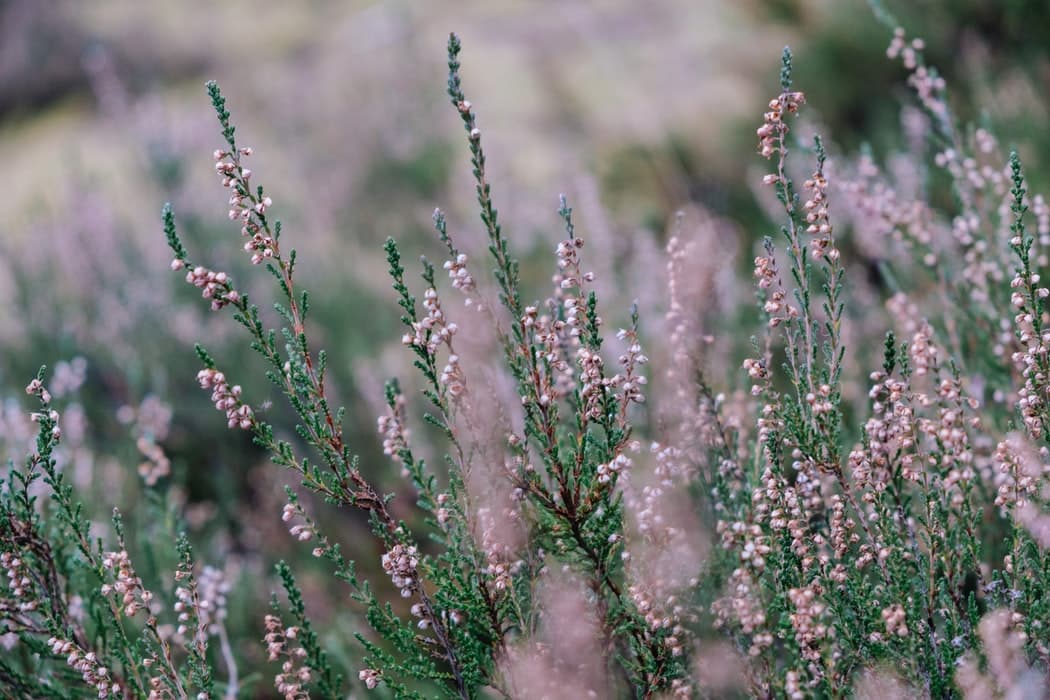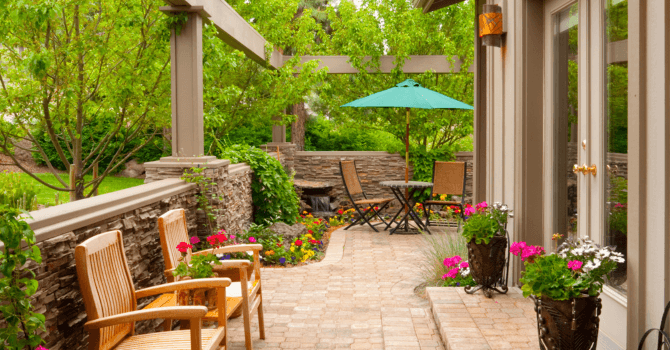5 Grass Alternatives for Your Backyard
By Editorial Team
Updated on November 7, 2023

With summer weather and sunshine knocking at your door, landscaping is most likely at the forefront of your mind. Even though your goal is to make it look nice, maintenance is rarely a cause for excitement. However, plants need their share of attention, and so does your lawn.
From mowing and trimming to fertilizing, keeping your lawn looking good is no easy task. This is why a lot more homeowners are considering an alternative to grass, but what are these options exactly?
Grass Alternatives
1)Native grasses
To create a native grass effect, there is no need to remove the entirety of your grass. Instead, allow for it to grow and then plant native plants in select areas.
Mixing the two will create a sort of feral, wild garden look, dotted with perennial grasses and wildflowers. If you are not entirely sure where to start, the following are some examples of plants that can be used to create this effect:
Viola cucullata;
Silverweed;
Breckland thyme;
Yarrow.
Aside from this suggestion, there are several other tips worth considering to create beautiful native grasses. First and foremost, we suggest mowing a walkway on your lawn so that you and your guests can walk freely without trampling it.
For those wishing to avoid doing even this sporadic upkeep, note that you should at least mow your lawn once a year, namely in the fall. As far as the time frame for flowers to bloom, it usually takes about a year. Lastly, we stress the importance of choosing local, native plants, as they adapt better to the region's climate.
Would like to know more about eco-friendly landscaping projects? Read our article Eco-friendly landscaping projects.
2) Native plants

Have you made up your mind and want to get rid of your entire lawn? The second option is to create an array of native plants that will completely take over your existing lawn.
So, what types of plants should you consider to create a stunning yet convenient environment? Here are some suggestions:
Willowherbs;
Lupine;
Scarlet beebalm;
Yarrow;
Blanket flowers;
Coneflower.
Designing a wildflower landscape is definitely a welcome change from traditional lawns and other types of mundane landscaping, but it does require some maintenance for the first two to three years to ensure optimum growth.
However, following this period, upkeep will be rather minimal and will consist of nothing more than basic maintenance; forget about fertilizer or lawn mowing, it will all be unnecessary.
Of course, if you want, you can always limit your selection to one or two varieties of wild plants to create your landscape. For example, yarrows are particularly dense plants, and their appearance is amplified by the distinctive tufted look of the leaves.
Given its many merits, including its ability to withstand foot traffic and drought, it is a solid choice in itself.
Are you looking for more information regarding your horticulture project? Check out our article Working with a Horticulturist: Average Prices and Things to Know.
3) Mixed Grass

For those on the fence, you may want to opt for a healthy balance of mixed grass. So the question remains, where do you start? Well, you can purchase a mix of seeds designed explicitly for this purpose and combine an array of plants that require little to no maintenance compared to Kentucky bluegrass (which is the traditional grass). To create a mixed grass look, mix the following seeds:
Creeping fescue;
White clover;
Ryegrass;
Bird’s-foot trefoil.
So, just what do you need to do to maintain mixed grass? Just a little watering and the occasional mowing, as required. Forget about fertilizers and pesticides - it is unnecessary! In terms of creeping fescue, note that it has a host of benefits, such as:
Resistant to droughts and red thread disease;
Maintains a natural/green appearance all summer long;
Drought-resistant;
Creates a particularly dense surface.
When it comes to white clovers, note that this plant has the benefit of adapting to various types of soil, as well as the ability to propagate quite rapidly once planted and thus lure pollinating insects.
However, to ensure healthy growth, you should prioritize fully sunlit areas. Although it requires infrequent mowing, white clovers are resistant to the cold and can withstand drought as well. This makes it a natural choice to replace your lawn!
Bird's-foot trefoil is also an exciting choice for those who are looking to entice colonizing insects. Like the white clover, this type of plant also helps control the level of nitrogen in the soil.
With regards to ryegrass, note that it is best to choose the year-round variety instead of perennials. The latter has a tendency to germinate much faster than the former. Given its similar characteristics to the above-mentioned plants, it will be a wise addition to any mixed grass.
Would like to realize a landscaping project? Read our article Landscaping and exterior renovation project.
The Benefits of Mixed Grass
There are many advantages to designing a mixed grass lawn with a variety of plants. First off, it creates an aesthetically pleasing patch of greenery. And, of course, to achieve a visually pleasing result, you have to play around with different kinds of foliage or colours.
On this note, mixing plants allows you to fully benefit from complementary plant cycles and have a green, shiny, and even-looking mixed grass lawn. Ultimately, it turns out that when various plants are planted together, there is some kind of mutual dependency.
As a result, should a plant be in poor health, nearby plants will provide support. This kind of mutual support will be very effective in keeping your lawn looking healthy.
Other Grass Alternatives
4) Creeping thyme (ground cover thyme)

It might not be the first idea to pop into your head, however, creeping thyme is perfect for dry or very dry environments, thus a perfectly viable option when creating a ground cover. Sowing your yard with Breckland thyme in seedling containers will help create a leafy surface of green and gray leaves, which will typically bloom small lavender-coloured flowers in the summer.
On top of its surprising possibilities for coverage, this plant will also enhance any flowerbed. Moreover, it can withstand foot traffic. The only drawback is that to thrive, it requires well-drained soil.
Moving on, you may want to look into shaggy sparrow-wort thyme as well. This plant will bloom with small white or pink flowers in the summer and is relatively dark green in colour. Like its alter ego, this one will need full sun exposure to remain healthy.
However, said plant specie should be grown in areas where it will not be trampled and where it will receive sufficient sunlight. Also, patience is a must, as thyme does not grow particularly fast.
Last but not least, thyme does not need to be watered or trimmed on a regular basis and it naturally gives off a sweet scent.
Do you need some advice to take care of your flowerbeds? Check out our article Garden flowerbeds: organization tips.
5) Roman chamomile ground cover
Besides thyme, which we have just mentioned, there are other plants that are perfectly appropriate when creating a ground cover. Among these, one thinks of Roman chamomile, especially. Roman chamomile has root-like stems (forming a branch on the ground), which give off a carpet-like appearance on the ground.
Note that Roman chamomile can withstand occasional foot traffic. And, lastly, it thrives in porous soils and requires a good amount of sunlight.
Are you looking for more information regarding the cost of your next landscaping project? Check out our article Landscaping: The Costs of Various Projects for 2022.
New Lawn Maintenance

Obviously, for your alternative lawn to look sharp, you will have to properly maintain it. Regardless of the option you choose, you should implement the following tips and tricks:
Limit the number of fast-growing plants;
Mow/trim yearly/biyearly;
Occasionally weed your plants.
When it comes to trimming, there are various options available. If patience is one of your virtues, then your obvious option is to use garden shears or a string trimmer. Or, you could choose to do it with a lawnmower, but make sure that you set the blade in the uppermost setting so as not to cut too close to the ground.
Read our article Choosing your flowers: annual or perennial? for advice on everything you need for your landscaping project.
Few Must-Know Yard Maintenance Tips
Should you decide to opt for one of the above-mentioned alternatives, implement the following tips to guarantee results that live up to your expectations. First, make sure to properly prepare the soil by allowing it to breathe, which means proceeding with soil decompaction, by 30 to 40 cm.
Next, break up compacted chunks of soil, and weed and rake the entire area. The outcome should be comparable to a seedbed.
Just how many plants should you put in? Here is a very pertinent question, whose answer will vary depending on the surface to be covered. The rule of thumb is to follow the planting distances (usually between 20 and 40 cm, depending on the species).
Remember that even if the plants you have chosen are drought-resistant, you should still water them a few times during their initial summer in case of intense heat.
Finally, make sure to weed your yard regularly to prevent unwanted weeds from spreading. Note that it is best done by hand, although it may be time-consuming.
Get 3 renovation quotes for your landscaping project
RenoQuotes.com can help you get quotes for your landscaping project. If you submit your project to us, we’ll put you in contact with top-rated contractors. Fill in the form on the homepage (it only takes a few minutes), and receive quotes from companies that are specialized in home renovations.
Dial 1-844 828-1588 to speak with one of our customer service representatives.
Looking for something else?
Related articles
The latest industry news, interviews, technologies, and resources.

Amanda Harvey
•07 Nov 2023
A fence protects the exterior of your home, and when well maintained, can add some serious curb appeal to any property. Since this structure is left outside day and night, it comes up against some severe conditions: snow, rain, sleet, heat, both freezing and melting water. Therefore, it's only natural that the paint on an outdoor fence should easily wear and fade.

Editorial Team
•07 Nov 2023
When it comes to the ins and outs of owning a home, the roof may be last on the list of things we put time and attention into. Of course, the roof is a fundamental aspect of any well-maintained home, and its longevity will greatly affect the life of your house overall. Ventilation is a key part of maintaining a roof, so if you hadn’t considered roof vents before this moment, now is as good a time as any.

Editorial Team
•07 Nov 2023
During the summer months, decks make for an entirely new living space in your backyard. It's the perfect spot to savour your first cup of coffee in the morning, share meals with your family, gather with friends for drinks, and, in the evening, wind down with a good book in hand.

Cynthia Pigeon
•07 Nov 2023
For some people, the prospect of living in a house that is a genuine time capsule is something of a reality. Perhaps you’re one of the many who’ve decided to keep the original retro design going since you’re drawn to its history. However, after a while, your home may need a little tweak here and there.

Editorial Team
•07 Nov 2023
As August comes to an end, it’s time for us once again to get busy and dig through the internet in search of the best articles on interior design, decor and renovation written this past month!